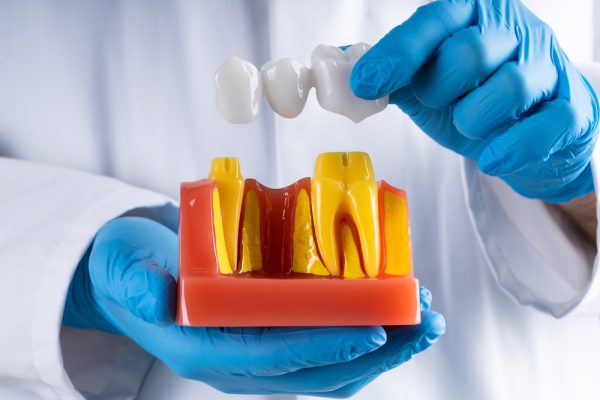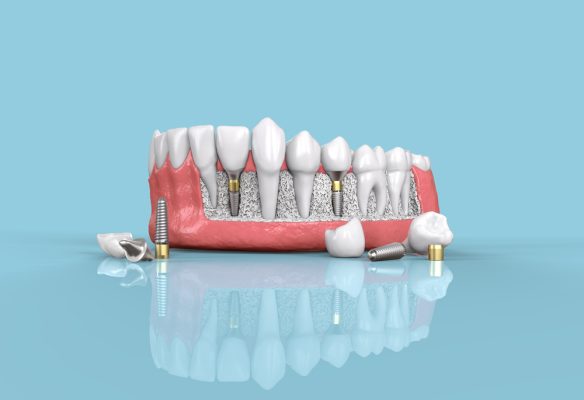Restore Your Smile With Dental Bridges
Losing a tooth can be a difficult experience, affecting both the appearance and functionality of your smile. Fortunately, dental bridges are a popular and effective treatment option for replacing missing teeth. They can improve the appearance of your smile, restore your ability to chew and speak properly, and prevent further dental complications.
Our Wasilla dentist has created a comprehensive guide to dental bridges so you can better understand if this tooth replacement is the best for you.

What Are Dental Bridges?
Dental bridges are prosthetic devices that are used to replace missing teeth. They consist of one or more artificial teeth that are supported by natural teeth or dental implants. Dental bridges can be made from various materials, including porcelain, ceramic, or metal.
Different Types of Dental Bridges
There are several types of dental bridges, including:
- Traditional Bridges: This is the most common type of dental bridge. It consists of one or more artificial teeth that are anchored to adjacent teeth using dental crowns.
- Cantilever Bridges: This type is used when there’s only one adjacent tooth available to support the artificial tooth.
- Maryland Bridges: This type of bridge is made of a metal or porcelain framework that’s bonded to the back of adjacent teeth. Maryland bridges are typically used to replace front teeth.
- Implant-Supported Bridges: This type of bridge is supported by dental implants instead of natural teeth. It’s a more durable and long-lasting option, but also a more costly one.

Dental Bridge Benefits
When replacing missing teeth with a dental bridge, patients may experience the following benefits:
- Restored smile
- Improved functionality
- Maintains facial structure
- Prevents further dental complications
- Long-lasting restoration
- Affordable solution
- Boost in confidence
- Minimally-invasive procedure
To schedule your consultation, contact Dr. Dawson at Northwind Dental by calling (907) 373-2440 today.
Dental Bridge Procedure
The dental bridge procedure involves preparing the adjacent teeth, called abutments, by reshaping them to support the bridge. A custom-made bridge, consisting of the replacement tooth or teeth (called pontics) and crowns for the abutment teeth, is then placed over the prepared teeth, restoring function and aesthetics. The bridge is typically cemented in place, providing a fixed solution for missing teeth. Proper care ensures its longevity, making regular dental check-ups essential.

The Costs of a Dental Bridge
The costs of a dental bridge will vary based on several factors. Factors that will influence the total cost include:
- Geographical location
- Materials used
- The type of dental bridge needed
- Number of teeth that need to be replaced
- Dentist’s expertise and experience
- Additional procedures
Contact our dental team today and we’ll gladly discuss pricing and help you figure out the best way to pay for your treatment.
Can You Get a Dental Bridge?
Being a candidate for a dental bridge depends on several factors. Our Wasilla dentist will consider the following before recommending a dental bridge:
- Location of Missing Teeth: A dental bridge requires adjacent teeth on either side of the gap to serve as abutments (support). If there aren’t stable teeth on either side, a bridge may not be an option.
- The Health of Adjacent Teeth: The supporting teeth need to be strong enough to support the bridge. This means they should be free of decay, gum disease, and should have good bone support. If the adjacent teeth are compromised, they might not be suitable as abutments, or they might require treatment first.
- Number of Missing Teeth: Traditional bridges are generally suitable for replacing one to three adjacent missing teeth. If more teeth are missing, or they’re spread out, other options like partial dentures or dental implants might be more appropriate.
- Oral Hygiene: Patients should have good oral hygiene habits or be willing to improve them. A bridge requires meticulous cleaning around and under the false tooth/teeth.
- Gum Health: Patients with untreated gum disease might not be good candidates for a dental bridge until the gum issues are addressed.
- Occlusion (Bite) Considerations: The way the upper and lower teeth come together (the bite) can influence the success of a bridge. If there are significant bite issues, they might need to be addressed either before or in conjunction with a bridge placement.
- Bone Loss: If a tooth has been missing for a long time, there can be significant bone loss in that area. While this doesn’t necessarily preclude someone from getting a bridge, it might make other options like implants more challenging without additional procedures like bone grafting.

Frequently Asked Questions
On average, dental bridges can last between 5 to 15 years, and even longer with proper care and maintenance. The lifespan of a bridge varies based on the type of bridge, materials used, oral hygiene practices, and regular dental check-ups. Implant-supported bridges tend to last longer than traditional or cantilever bridges.
Unlike natural teeth, dental bridges can’t be whitened using traditional teeth-whitening methods. This is why it’s essential to select a shade that matches your desired tooth color when first getting the bridge. If your bridge does become stained, it may require professional cleaning or, in extreme cases, replacement to restore its original appearance.
Schedule a Consultation With Dr. Dawson Today
Are you ready to replace your lost teeth? Don’t wait any longer! Contact our dentist in Wasilla today by calling (907) 373-2440 and schedule your consultation. Dental bridges can restore your smile and help you find the confidence you once had. We can’t wait to meet you!
